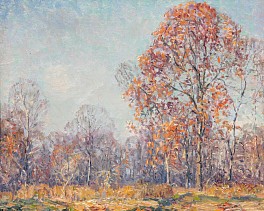BIOGRAPHY

WILSON HENRY IRVINE
(1869-1936)
Born in Illinois, Wilson Henry Irvine showed an early talent for drawing, and by his late teens he was using an airbrush. Early in his career he was involved in commercial art, and by 1895, he was enrolled in evening classes at The Art Institute of Chicago. By 1900, Irvine was exhibiting landscapes and becoming actively involved in the Chicago art community as one of the founding members of that city’s Palette and Chisel Club and the Cliff Dwellers. From 1914 to 1917, the artist spent his summers painting at Old Lyme, Connecticut, where he became affiliated with the art colony there, and in 1918, he purchased a home in neighboring Hamburg. In 1926 he was elected an associate of the National Academy of Design.
Described by one scholar as having “a keenly imaginative mind,” Irvine experimented with his art throughout his career. His “prismatic paintings,” conceived by looking at his subject through a prism, were first exhibited in 1930 at the Grand Central Art Galleries. Around that same time, he also produced “aquaprints,” which introduced naturalistic forms to marbleized paper.
Memberships
National Academy of Design, New York, NY
Lyme Art Association, Lyme, CT
Chicago Society of Artists, Chicago, IL
Salmagundi Club, New York, NY
National Arts Club, New York, NY
Awards
Art Institute of Chicago (prizes awarded in 1912, 1915, 1916, 1917)
Panana-Pacific Exposition, 1915 (silver medal)
Chicago Society of Artists, 1916 (medal)
Connecticut Academy of Fine Arts, 1929 (prize)
Lyme Art Association, 1934 (prize)
Select Public Collections
Art Institute of Chicago, Chicago, IL
National Arts Club, New York, NY
Benton Museum of Art, Storrs, CT
Lyme Historical Society, Lyme, CT
Wilson Henry Irvine
(1869-1936)
Born in Illinois, Wilson Henry Irvine showed an early talent for drawing, and by his late teens he was using an airbrush. Early in his career he was involved in commercial art, and by 1895, he was enrolled in evening classes at The Art Institute of Chicago. By 1900, Irvine was exhibiting landscapes and becoming actively involved in the Chicago art community as one of the founding members of that city’s Palette and Chisel Club and the Cliff Dwellers. From 1914 to 1917, the artist spent his summers painting at Old Lyme, Connecticut, where he became affiliated with the art colony there, and in 1918, he purchased a home in neighboring Hamburg. In 1926 he was elected an associate of the National Academy of Design.
Described by one scholar as having “a keenly imaginative mind,” Irvine experimented with his art throughout his career. His “prismatic paintings,” conceived by looking at his subject through a prism, were first exhibited in 1930 at the Grand Central Art Galleries. Around that same time, he also produced “aquaprints,” which introduced naturalistic forms to marbleized paper.
Memberships
National Academy of Design, New York, NY
Lyme Art Association, Lyme, CT
Chicago Society of Artists, Chicago, IL
Salmagundi Club, New York, NY
National Arts Club, New York, NY
Awards
Art Institute of Chicago (prizes awarded in 1912, 1915, 1916, 1917)
Panana-Pacific Exposition, 1915 (silver medal)
Chicago Society of Artists, 1916 (medal)
Connecticut Academy of Fine Arts, 1929 (prize)
Lyme Art Association, 1934 (prize)
Select Public Collections
Art Institute of Chicago, Chicago, IL
National Arts Club, New York, NY
Benton Museum of Art, Storrs, CT
Lyme Historical Society, Lyme, CT
